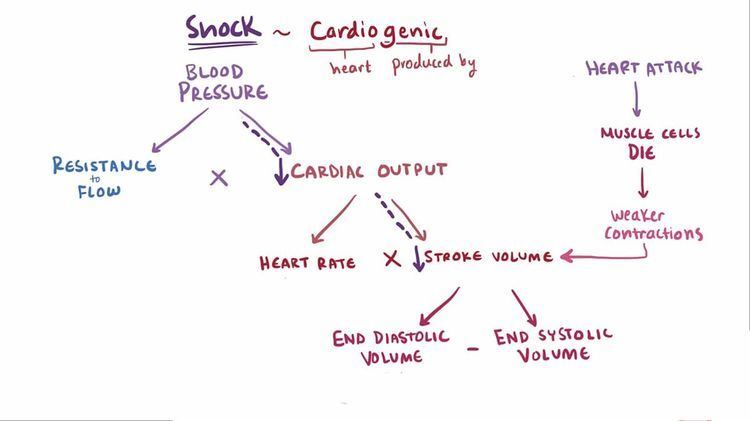ICD-9-CM 276.52 MeSH D020896 | ICD-10 E86, R57.1, T81.1 MedlinePlus 000167 | |
 | ||
Hypovolemia, or oligemia, (also hypovolaemia or oligaemia) is a state of decreased blood volume; more specifically, decrease in volume of blood plasma. It is thus the intravascular component of volume contraction (or loss of blood volume due to things such as bleeding or dehydration), but, as it also is the most essential one, hypovolemia and volume contraction are sometimes used synonymously.
Contents
Hypovolemia is characterized by sodium depletion (salt depletion) and thus differs from dehydration, which is defined as excessive loss of body water.
Causes
Common causes of hypovolemia are
Excessive sweating is not a cause of hypovolemia, because the body eliminates significantly more water than sodium.
Diagnosis
Clinical symptoms may not be present until 10–20% of total whole-blood volume is lost.
Hypovolemia can be recognized by tachycardia, diminished blood pressure, and the absence of perfusion as assessed by skin signs (skin turning pale) and/or capillary refill on forehead, lips and nail beds. The patient may feel dizzy, faint, nauseated, or very thirsty. These signs are also characteristic of most types of shock.
Note that in children compensation can result in an artificially high blood pressure despite hypovolemia. Children will typically compensate (maintain blood pressure despite loss of blood volume) for a longer period than adults, but will deteriorate rapidly and severely once they do begin to decompensate. This is another reason (aside from initial lower blood volume) that even the possibility of internal bleeding in children should almost always be treated aggressively.
Obvious signs of external bleeding should be noted while remembering that people can bleed to death internally without any external blood loss. ("Blood on the floor, plus 4 more" = intrathoracic, intraperitoneal, retroperitoneal, pelvis/thigh)
There should be considered possible mechanisms of injury that may have caused internal bleeding, such as ruptured or bruised internal organs. If trained to do so and if the situation permits, there should be conducted a secondary survey and checked the chest and abdomen for pain, deformity, guarding, discoloration or swelling. Bleeding into the abdominal cavity can cause the classical bruising patterns of Grey Turner's sign or Cullen's sign.
Stages of hypovolemic shock
Usually referred to as "class" of shock. Most sources state that there are 4 stages of hypovolemic shock; however, a number of other systems exist with as many as 6 stages.
The 4 stages are sometimes known as the "Tennis" staging of hypovolemic shock, as the stages of blood loss (under 15% of volume, 15–30% of volume, 30–40% of volume and above 40% of volume) mimic the scores in a game of tennis: 15, 15–30, 30–40 and 40. It is basically the same as used in classifying bleeding by blood loss.
The signs and symptoms of the major stages of hypovolemic shock include:
Field care
Emergency oxygen should be immediately employed to increase the efficiency of the patient's remaining blood supply. This intervention can be life-saving.
The use of intravenous fluids (IVs) may help compensate for lost fluid volume, but IV fluids cannot carry oxygen in the way that blood can; however, blood substitutes are being developed which can. Infusion of colloid or crystalloid IV fluids will also dilute clotting factors within the blood, increasing the risk of bleeding. It is current best practice to allow permissive hypotension in patients suffering from hypovolemic shock, both to ensure clotting factors are not overly diluted and also to stop blood pressure being artificially raised to a point where it "blows off" clots that have formed.
Hospital treatment
Fluid replacement is beneficial in hypovolemia of stage 2, and is necessary in stage 3 and 4. See also the discussion of shock and the importance of treating reversible shock while it can still be countered.
For a patient presenting with hypovolemic shock in hospital the following investigations would be carried out:
The following interventions would be carried out:
History
In cases in which loss of blood volume is clearly attributable to bleeding (as opposed to, e.g., dehydration), most medical practitioners of today prefer the term exsanguination for its greater specificity and descriptiveness, with the effect that the latter term is now more common in the relevant context.
